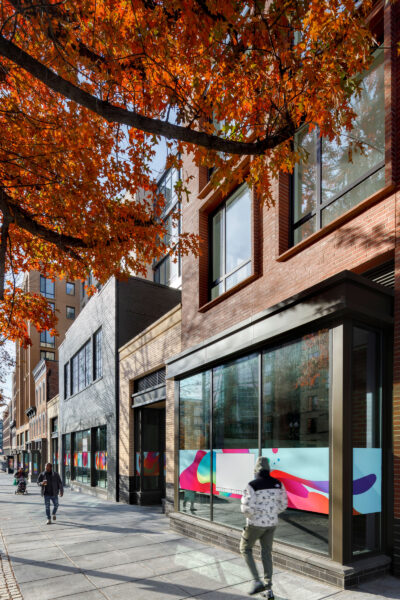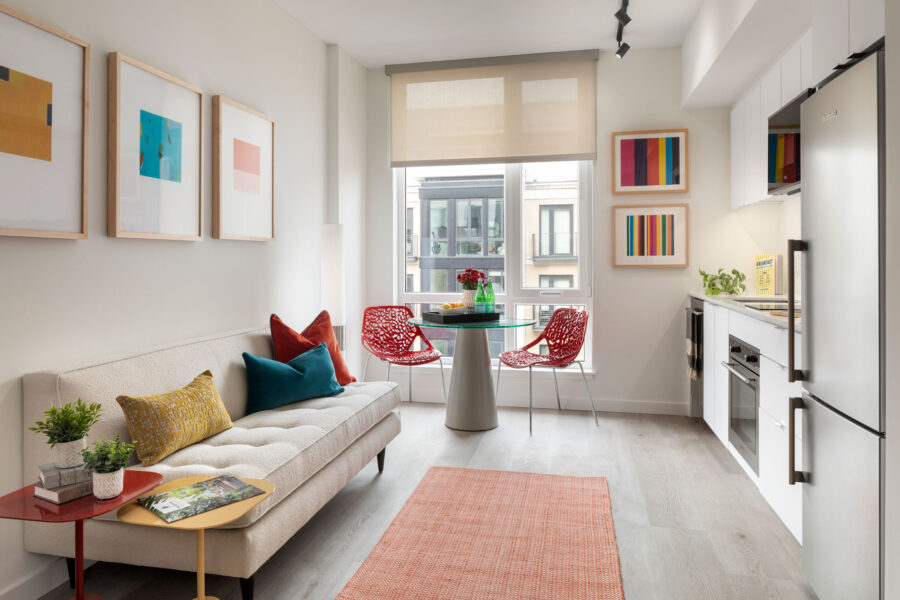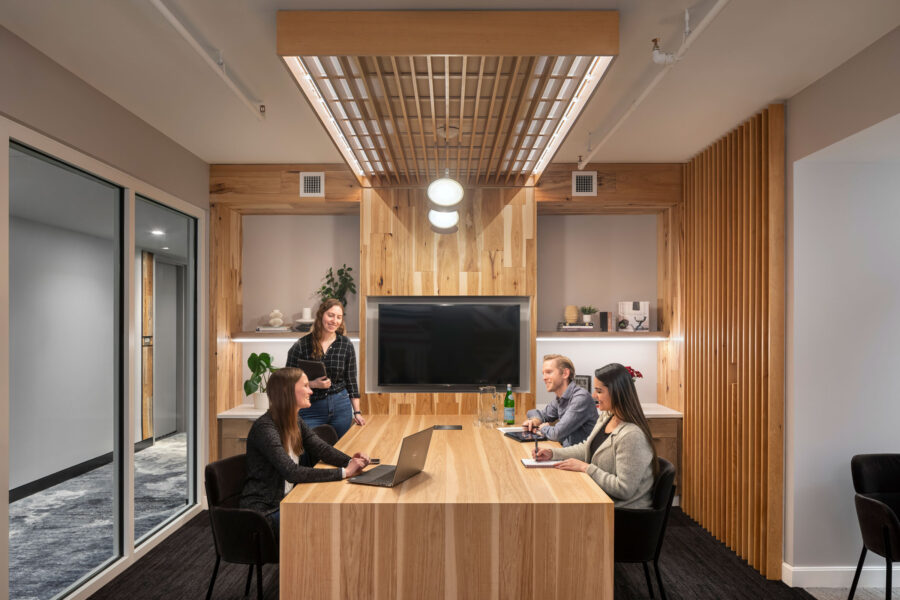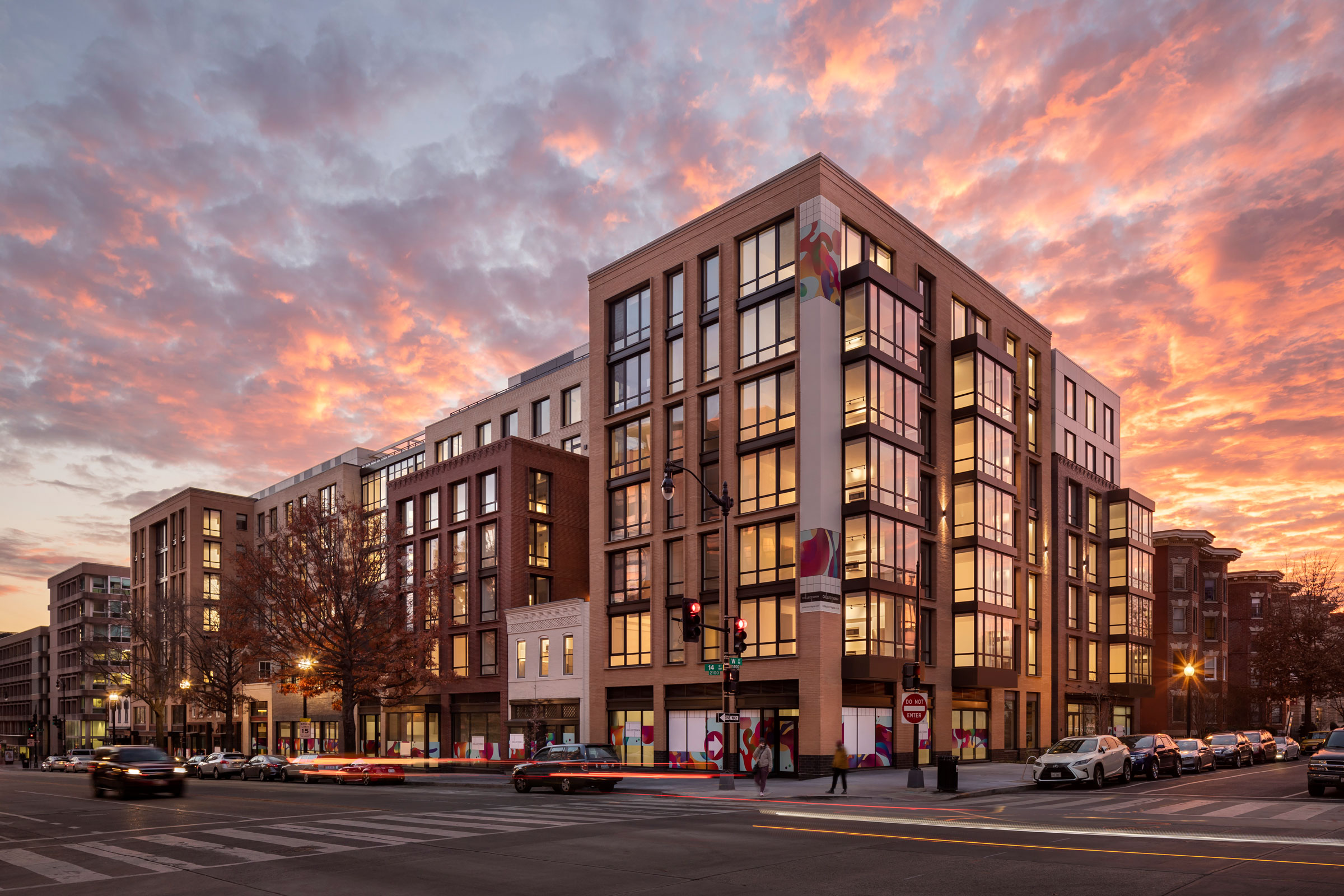Story at a glance:
- The Perkins Eastman Collection 14 project incorporates historic structures and multiple uses while adding to the character of the community.
- More than 200 apartments are alongside plentiful retail, office and event space in this Washington, DC project.
Collection 14 is the sum of many parts—or at least that’s how it looks from the sidewalk. Initially conceived as two distinct buildings, the project grew to encompass a full city block, incorporating a handful of historic properties while maximizing space and livability for a 21st century clientele.
Two parcels on the block—14th St. between V and W streets—had belonged to Martha’s Table, a longtime D.C. social services provider. As the neighborhood upscaled over the last 15 years, the nonprofit found itself with fewer locals to serve but valuable real estate. It opted to sell and build a new headquarters in another area with the proceeds.
Part of the design process for that project, Perkins Eastman DC began looking for developers interested in redeveloping the 14th St. site, attracting family-owned Madison Investments to partner. “We were looking to take the character of the place and make sure that we added to it,” says Tim Bertschinger, associate principal and project manager for Collection 14. “The developers felt a sense of responsibility because they’ve been working in the city for a long time.”

Exteriors emulate the warehouse-industrial vernacular of the 14th Street corridor, incorporating the historic facades on the site. Photo by Andrew Rugge
Madison initially envisioned building two apartment towers, an arrangement that would have left both “with big, blank faces on the sides,” Bertschinger says. Perkins Eastman DC convinced the developers to acquire another narrow parcel and the gas station at the north end of the block, leaving a contiguous site with two historic facades and a protected building in the middle. It presented a design challenge but also an opportunity.
The purchases allowed Perkins Eastman DC to take advantage of the site’s slope to adjust the project’s official measuring point upward in keeping with D.C. height restrictions. “By acquiring the additional sites we were able to add some additional floors to the project, including a mezzanine that created 7,000 square feet of office space,” Bertschinger says.

Drawing courtesy of Perkins Eastman
The historic structure was an automobile showroom dating to 1918. Perkins Eastman DC surgically excavated the development’s parking garage beneath it, leaving the building intact on stilts and needle beams. Once the concrete set, the rest of the development went up around it.
The design reconceived the showroom as a retail space with rooftop terrace and event space. “We repurposed it in a way that you can experience the inside of the building from the retail side, but you can also take in the whole environment from the rooftop terrace,” Bertschinger says. EHT Traceries helped the firm restore the historic facades, and the leasing office occupies a reconstructed townhouse. Seven-story residence buildings frame the varying heights and setbacks of the project, which lend the block a walkable scale and give it the feel of “a collection of books on a bookshelf”—hence the name Collection 14.

Photo by Andrew Rugge
With 233 rental apartments, retail, office and event space, the flexible urban environment satisfies multiple goals for sustainability. “Sustainability is more than just environmental value; it’s also social and economic value,” says Heather Jauregui, Perkins Eastman’s director of sustainability. “We look at the wellness of the planet and the wellness of people at the same time.”
For planet, the building boasts optimized energy performance thanks to a vapor-permeable envelope with three inches of insulation, low-flow plumbing, and central hot water systems. Daylighting strategies make more than 55% of the space daylight-autonomous, meaning electric lights are unnecessary when the sun shines. “It’s a pretty high threshold for any building to reach,” Jauregui says. Collection 14 doesn’t have a repeating floorplan, instead stacking kitchens and bathrooms to create efficiencies.

The design stacks kitchens and baths to create economies during construction. All units benefit from daylighting, operable windows, low-VOC materials, and energy-efficient appliances. Photo by Andrew Rugge
And with 100-year rain events now happening yearly on the Atlantic coast, the entire development features green roofs, plus a bioretention pond planted with marsh grasses to hold stormwater runoff back from the sewers. All paints and coatings, flooring, and wall coverings meet or exceed VOC content and emissions thresholds for six categories in the LEED system, and more than 50 products specified had health product declarations (HPDs). “We can be more assured that we’re not putting toxic materials into the spaces to begin with,” Jauregui says. “We paid a lot of attention early on to creating quality indoor environments for the residents.”
A VRV and dedicated outdoor air system provides fresh air with 100% return to rooftop units that recover conditioning energy; residential units also offer operable windows. While LEED certification was a permitting requirement, the firm achieved LEED Gold through its holistic design process.
The final product is almost a neighborhood unto itself. “The creation of a place that has places to live, places to work, and places to shop and visit takes advantage of the asset,” Bertschinger says. “That kind of urbanism is a big part of sustainability.

Photo by Andrew Rugge

The lobby’s green wall brings the outdoors in with shade plants, wood floors, and a sleek receiving counter. Photo by Andrew Rugge
Environmental, economic, and social benefits attract people to a place.” In the heart of a burgeoning cultural area, the building uses upscale finishes and includes areas for public artworks. Biophilic design incorporates natural materials to bring the outside in. It also offers excellent transit options—with 69 parking spots, EV chargers, and bicycle parking with showers and lockers.
“The location of this project is a big part of the sustainability story,” Jauregui says. “Collection 14 is a block from the Metro and has great bus lines. If you design a high-performance building, but it’s in the middle of nowhere and everyone has to drive there, is it really sustainable?” The firm’s holistic approach and attention to detail helped Collection 14 enhance the neighborhood, Bertschinger says. “Nothing about this project is groundbreaking or trendsetting,” he says. “It’s not about the 80% of making a new thing; it’s about the 20% of making it perfect. There’s no one solution; there’s only a process.”




